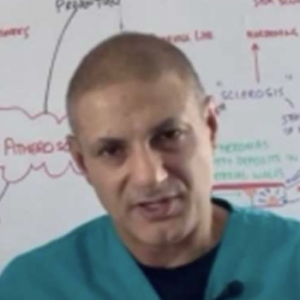Imagine your body as a castle, with invaders trying to enter and take over. To prevent attacks, the castle has invested in several defensive strategies. There is a highly efficient army called the White Cells, which are made up of many divisions to repel any attacks.
The infantry is made up of crazed suicidal warriors called neutrophils who patrol streets (blood vessels), looking for any signs of invasion (infection). They carry a net (neutrophil extracellular trap) to ensnare any invaders (bacteria), and then they start to eat them in a process called phagocytosis. They are fanatical warriors who readily throw themselves into battle, often sacrificing themselves, but unfortunately, they also cause collateral damage.
Another division, the Macrophage department, consists of guard dogs placed in strategic locations; they are not free to move around the streets but stay in one place to guard a specific location (tissue). They are transported to their locations when they are still puppies. Like the neutrophils, these guard dogs like to eat any invaders, and due to their size, they can eat a lot, which is why they are called macrophages or big eaters. In addition to eating bacteria, they help gather information about the type of invaders by presenting pieces (antigens) of the invader on its skin, so it is a type of antigen-presenting cell (APC).
When these army units encounter the invaders, they warn that an invasion is occurring. These panic signals released by the cells are called cytokines and are the signals that alert other military units (immune cells) and guide them to the site of the battle.
How can the army tell friends from foe? These army units have special senses that lock onto anything that doesn’t belong to the castle. They can recognise self from not self. They can recognise the distinctive swords or features of the enemy known as PAMP, pattern recognition molecular patterns, and they use a specific high-tech device called a toll-like receptor.
Military intelligence comprises the dendritic cells that patrol the streets and gather battlefield information. They grab hold of any invaders and rip them into pieces (antigens)to help identify who the attackers are. Once they gather the antigens from the battlefield, they travel to the military headquarters (lymph nodes) for about a day to recruit the special forces.
The neutrophils and macrophages comprise the military section known as the INNATE IMMUNE system. They are the troops on the ground that act to repel any immediate threat from invaders. When the battle continues and the invaders grow in numbers (bacteria can reproduce by binary fission, so after a few hours, there will be millions), the special forces (adaptive immune system) are summoned.
Another part of innate immunity is the swarms of trained bees called the complement system. They can recognise invaders and swarm all over them, stinging them and covering them with themselves. Being covered with a swarm of angry bees makes it very difficult for an attacker to go unnoticed, and this swarming mess soon gets the attention of the neutrophils and the macrophages.
Other strategies to deter attacks include defences outside the castle. The castle is built in a salt and acid-filled desert (skin). Poisonous chemicals called defensins also bubble up from the ground. So, the area is highly inhospitable. However, some hardy barbarians can live in these harsh environments and have made it their home (commensal bacteria). They can live off the scarce resources and have agreed with the castle. Their presence is tolerated outside the castle gates so long as they don’t let other barbarian hordes settle there. This relationship works well when the castle’s walls are intact; however, any time there is a breach in the walls, these friendly barbarian hordes can also invade.
Once it reaches the military headquarters (lymph nodes), the dendritic cell searches for the special forces’ commanders (Helper T cells) who have had experience dealing with this invader. It presents the battlefield data (antigen) on a particular receptor called the MHC II receptor. Only those helper T cells that recognise the antigen and know how to fight the invader become activated.
Think of the antigen presented on the MHC II receptor as part of a puzzle, and the corresponding half of the puzzle is on the helper T cell. When there is a match, a second signal is required. A two-step authentication process is necessary because the special forces are so powerful that the system must ensure it is only activated when needed. Once the dendritic cell has delivered its message, it deletes it to stop the continual activation of the special forces’ units.
When the correct special forces commander has been selected, it leaves and begins to make clones of itself in the lymph node. After about 5 days, enough helper T cells follow the cytokine trail and arrive at the battlefield.
When the helper T cells arrive at the battle, they do not take part in actual fighting but take over the command. Usually, the macrophages and neutrophils attack, but they gradually become tired and die off. However, when the helper T cells arrive, they encourage these flagging warriors to make them even more deadly. They become super soldiers.
Meanwhile, elsewhere in the lymph nodes, other cells are surveying the detritus and antigens arriving from the battlefield. These are the weapons factories or virgin B cells. When the B cell recognises the antigen, it produces general weapons (antibodies) specific to that pathogen and clones itself. But these weapons are not super specific; to make the deadly weapons, the B cells need to be activated by the helper T cells.
The B cells take the antigen pieces and put them on an MHC II receptor. When a helper T cell for that antigen locks onto the antigen in the MHC II receptor, the B cell becomes an activated B cell (plasma cell), which is to make powerful super specific weapons (antibodies) for that pathogen. It releases these weapons to flood the battle site.
The antibodies are like arrows that target the invaders and work by making the invaders more accessible to the macrophages and neutrophils. It’s like putting barbeque sauce on the invaders; this process is called opsonisation. The newly invigorated macrophages and neutrophils find these opsonised invaders irresistible and begin eating them faster and more enthusiastically. Also, the antibodies stick to the invaders’ bodies, slowing them down. The antibodies also make the invaders clump together, making it easier for the macrophages and neutrophils to attack them.
All the while, the helper T cell is monitoring the situation. When the invaders have been defeated, the helper T cell orders the army to step down and kill themselves to avoid any more collateral damage. Some T and B cells (memory cells) are allowed to live to have a memory of the invader, so if that particular invader (pathogen) strikes again, the response will be far swifter.


